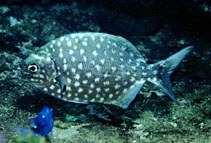| Family: |
Kyphosidae (Sea chubs) |
| Max. size: |
53 cm TL (male/unsexed) |
| Environment: |
reef-associated; marine; depth range 1 - 40 m |
| Distribution: |
Eastern Pacific: Gulf of California to Ecuador, including the Galapagos Islands (Ref. 9310); and Peru (first record). |
| Diagnosis: |
Body oval, somewhat elongate, and compressed (depth contained less than 2.0 times in standard length); head and mouth small; teeth highly characteristic, forming a single anterior row in each jaw, incisiform and somewhat lanceolate in shape, resembling the head of a golf club, their roots compressed and horizontally set, forming a striated plate inside the mouth; vomer toothed; dorsal fin with 13 soft rays; lateral line scales 59 to 61; first anal ray longer than subsequent rays; body entirely dark gray, with dark stripes on flanks; sometimes with white spots (Ref. 55763). |
| Biology: |
Sometimes seen in schools of K. analogus, also known to school and graze with Prionurus laticlavius. Stays close to shore in shallow waters. Feeds mainly on attached algae, occasionally ingests plankton and benthic invertebrates (Ref. 28023). |
| IUCN Red List Status: |
Least Concern (LC); Date assessed: 23 May 2007 Ref. (130435)
|
| Threat to humans: |
harmless |
Source and more info: www.fishbase.org. For personal, classroom, and other internal use only. Not for publication.
